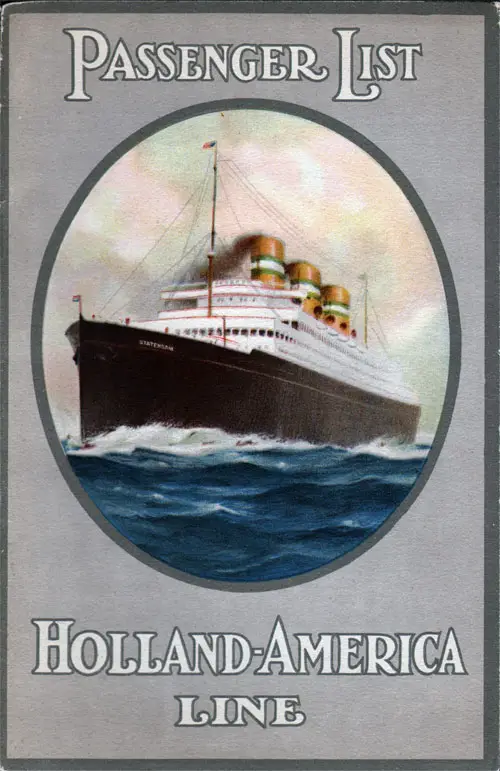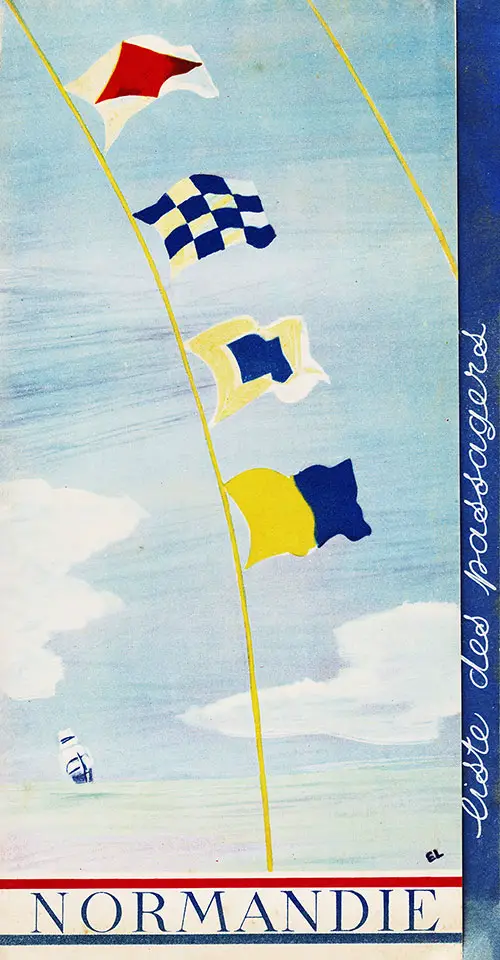What Are Passenger Lists?

Front Cover of a First Class Passenger List for the SS Rotterdam of the Holland-America Line, Departing Friday, 9 October 1931 from Rotterdam to New York via Boulogne-sur-Mer and Southampton, Commanded by Captain Lieuwen. | GGA Image ID # 17cb90dabf
📑 What Are Passenger Lists?
Passenger lists were more than just rosters of names — they were essential travel documents, social souvenirs, and, today, invaluable historical records. From the 19th century through the mid-20th, nearly every ocean voyage produced a printed passenger list, often preserved by families as keepsakes of their crossing.
✨ Definition & Purpose
A passenger list is a printed booklet or folio prepared by the steamship line, usually given to every cabin-class traveler. It typically included:
- Names of passengers (often grouped by class of travel)
- Senior officers and staff of the ship
- Information for travelers (meal times, services, regulations)
- Illustrations or photographs of the vessel
- Fleet lists or sailing schedules for the company
- Advertisements for hotels, railways, or future voyages
These lists served two main functions:
Souvenir & Social Tool – Travelers could see who was aboard, arrange introductions, and later keep the booklet as a memory of their voyage.
Marketing Piece – Steamship lines treated lists as subtle advertising, designing beautiful covers that passengers would take home, show friends, and hopefully inspire repeat bookings.
📰 Historical Context
An 1891 travel guide described passenger lists as:
“Every traveler may have at least one interesting souvenir of the voyage across the Atlantic. The names of the passengers…are neatly printed upon folios along with a blank chart for recording the progress of the voyage…They are not only prized as souvenirs, but they are invaluable in assisting one to make acquaintances—or avoid them.”
Many lists even included a blank log chart so passengers could record the ship’s daily progress, and some ships published onboard miniature newspapers with gossip, poems, and entertainment reviews — a glimpse of life at sea.
🧭 Why Passenger Lists Matter Today
For modern audiences, passenger lists remain invaluable:
- Genealogists – Trace immigrant ancestors, family migrations, or elite leisure travel.
- Historians – Study social class, migration trends, and transatlantic culture.
- Collectors – Value covers with fine artwork, rare ships, or historically significant voyages.
- Educators & Students – Use lists as primary sources to explore global history, travel, and design.
Passenger lists don’t just document a journey — they reveal who was aboard, why they traveled, and how ocean liners connected continents.
🔎 Alternate Names for Passenger Lists
Passenger lists are referred to in many ways, depending on context:
- Ship Manifests (often confused with immigration documents)
- Ellis Island Passenger Lists
- Ships List / Ship Lists
- New York Passenger Lists / Boston Passenger Lists
- Immigrant Passenger Lists
- German Passenger Lists
- Steamship Passenger Records
These terms are often used interchangeably, though technically manifests were government immigration records, while passenger lists were souvenirs issued by the steamship companies.
📚 Related Reading
Passenger List Collections
– Browse nearly 2,000 passenger lists in the GG Archives.
Who's Who On Board: The Secrets In The Passenger List
– How passenger rosters reveal social networks and stories.
Difference Between Passenger Lists & Manifests
– Understanding government vs. souvenir documents.
Ephemera & Design in Passenger Lists
– The art and advertising behind these collectible booklets.

Front Cover of a Tourist Third Cabin Passenger List from the SS Normandie of the CGT French Line, Departing Wednesday, 24 July 1935 from Le Havre to New York via Southampton, Commanded by Captain René PUGNET O. | GGA Image ID # 1f36e9f20c

Front Cover of a Tourist Third Class Passenger List for the MV Vulcania of the Cosulich Line - Trieste, Departing 19 August 1930 from Naples to New York via Cannes, Commanded by Captain Antonio Hreglich. | GGA Image ID # 1ecdb0195d
📚 Teacher & Student Resource
Many of our FAQ pages include essay prompts, classroom activities, and research guidance to help teachers and students use GG Archives materials in migration and maritime history studies. Whether you’re writing a paper, leading a class discussion, or tracing family history, these resources are designed to connect individual stories to the bigger picture of ocean travel (1880–1960).
✨ Educators: Feel free to adapt these prompts for assignments and lesson plans. ✨ Students: Use GG Archives as a primary source hub for essays, genealogy projects, and historical research.
📘 About the Passenger List FAQ Series (1880s–1960s)
This FAQ is part of a series exploring ocean travel, class distinctions, and the purpose of passenger lists between the 1880s and 1960s. These resources help teachers, students, genealogists, historians, and maritime enthusiasts place passenger lists into historical context.
- Why First & Second Class lists were produced as souvenirs.
- How class designations like Saloon, Tourist Third Cabin, and Steerage evolved.
- The difference between souvenir passenger lists and immigration manifests.
- How photographs, menus, and advertisements complement list research.
👉 Explore the full FAQ series to deepen your understanding of migration, tourism, and ocean liner culture. ⚓
📜 Research note: Some names and captions were typed from originals and may reflect period spellings or minor typographical variations. When searching, try alternate spellings and cross-check with related records. ⚓
Curator’s Note
For over 25 years, I've been dedicated to a unique mission: tracking down, curating, preserving, scanning, and transcribing historical materials. These materials, carefully researched, organized, and enriched with context, live on here at the GG Archives. Each passenger list isn't just posted — it's a testament to our commitment to helping you see the people and stories behind the names.
It hasn't always been easy. In the early years, I wasn't sure the site would survive, and I often paid the hosting bills out of my own pocket. But I never built this site for the money — I built it because I love history and believe it's worth preserving. It's a labor of love that I've dedicated myself to, and I'm committed to keeping it going.
If you've found something here that helped your research, sparked a family story, or just made you smile, I'd love to hear about it. Your experiences and stories are the real reward for me. And if you'd like to help keep this labor of love going, there's a "Contribute to the Website" link tucked away on our About page.
📜 History is worth keeping. Thanks for visiting and keeping it alive with me.
